Why I Picked It Up:
I was charged with going to spend money at a Scholastic Warehouse Sale back around Christmas time (I love being a librarian!), and Rolling Thunder was one that I just grabbed off a “bargain” shelf because I’m always looking for hardback picture books to add to our collection. Honestly, I didn’t really look through it much at the time because I saw the author, Kate Messner, and I knew it would be good. (I’ve loved everything I’ve read by her – we’ve reviewed two of them here: Ranger in Time (series) and Capture the Flag).
Why I Finished It:
When I finally had a chance to look through Rolling Thunder more carefully, I got really excited. One of our favorite things to do is combine social studies and literature (we have whole sessions on doing that!). Our social studies standards expect us to help students understand how and why we celebrate various holidays, but most of the texts we’ve seen so far are fairly predictable. Rolling Thunder, however, is a refreshingly non-traditional look at an aspect of Memorial Day. It is a fictionalized account of the Rolling Thunder Ride for Freedom that takes place every year in Washington D.C. where veterans and supporters gather to pay tribute to our military members with a motorcycle ride through the city as a demonstration to bring awareness and accountability for POWs and MIAs.
Beyond the cool current event connection, Rolling Thunder is just a GORGEOUS book. The illustrations are rich and vibrant, and they contain so many details that you could really spend time just studying them by themselves. But, paired with Messner’s lyrical poetry, Rolling Thunder, is a compelling picture book.
Who I Would Give It To:
Elementary social studies teachers (in Texas, 2nd and 5th grade specifically mention Memorial Day) need this book for sure, but also parents. This is a great book to share the importance of our military, freedom, and pride in being American.
Integration Ideas
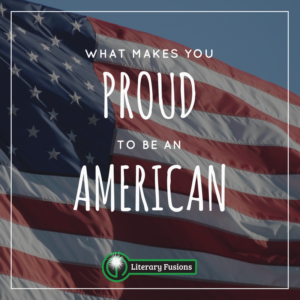
Theme and Essential Questions
Identity is a huge theme of this book. The boy in the story learns about his identity and his heritage by participating in the ride with his Grandpa, but we also learn about our identity as Americans and the book calls attention to the identity of the POWs and MIAs that have been left behind.
What does it mean to be an American? What events have shaped our identity as Americans today? How do we show that we are “proud to be American”? How do background and culture shape your identity?
This is a powerful moment to have with your students. As the teacher, decide how complex you want the class conversation to be on identity. Ask students to think about their identity and celebrate their differences, but then come together to discuss the class identity. How are we similar, even though we have differences? Then take it out a little further to discuss our national identity.
Social Studies: Current Events and Research
In just a few weeks, the 31st Rolling Thunder Ride will take place on Memorial Day. Research the event by browsing their website: https://www.rollingthunderrun.com/ You can also read more about the organization here: http://www.rollingthunder1.com/ The history of the organization will be a great conversation starter as students learn about parts of social studies that aren’t as popular or widely covered.
Have students research in pairs or individually (teacher hack: more than two means one student is not participating). Provide organizers for students who need them. If your students are young or haven’t done much research, have the class develop questions to research together. If the students are experienced researchers or are a little older, have them develop questions they want to know about the ride. As students find the answers to their questions, challenge them to think of one or two more questions they have now that they read a little more. After all, that’s what inquisitive minds do!
Once students have researched, instead of making each student present to the whole class, turn on music and play musical walk and pair. Students walk around the room as the music is played and then when the music stops they find a person nearby to share the answer to one of their questions. One person shares for thirty seconds and then the next person shares for thirty seconds. Turn the music back on and repeat a few more times.
Social Studies: Landmarks and Symbols
Rolling Thunder is completely packed with important landmarks and symbols as well. Tucked away in the illustrations you can spot most of the important monuments in Washington D.C. (ex. Lincoln Memorial, Washington Monument, Capitol Building, Vietnam Veterans Memorial.)The riders in the story end up at the Vietnam Veterans Memorial, which is referred to as The Wall, but most of the monuments aren’t named in the text. The text talks about peace signs and a “flag of white and black / for those who never made it back.” Challenge your students to find and identify as many symbols or landmarks as they can!
Author’s Craft: Reading and Writing
Visualization/Word Choice/Couplets/Sentence Variety
While this might seem like a lot to group together, there isn’t really any way to isolate these ideas because they’re all so expertly intertwined to produce an overall feeling and emotion for the reader.
The entire story is written in couplets (see ideas for teaching couplets here.) By nature, couplets feel a bit choppy to me, but they propel the story along really well, and you can almost feel the motion of the ride in the lines of the story. After the book has been read all the way through, ask the students if they can hear the words that rhyme. On an overhead or chart paper, mark the rhyme scheme to show students the pattern Messner uses. Then take some time to talk about spelling patterns and what sounds are creating the rhyme. Having students memorize a list of spelling words, is not as powerful as noticing and discussing the spelling patterns in a fabulous picture book like this one! In this example, take the words ‘cheer’ and ‘near’. Don’t give the information to the students, but begin the conversation and let the students carry the work! Say: “Near and cheer in this couplet rhyme, but why?” Let students say they hear the ‘ear’ sound. Prompt them to begin looking at the spelling patterns and guide them into discussing that ‘ear’ and ‘eer’ both have the same sound. Ask students what other words have that sound and begin sorting those words as ‘ear’ or ‘eer’.
Messner also uses her sentence length to add the motion and emotion in Rolling Thunder. The book deals with weighty concepts that are simplified into short, simple, sometimes only one or two word, sentences. They seem to accentuate an almost dream-like state in which the main character finds himself. He’s participating in the event, but not fully grasping the importance, but realizing it’s something special as he catches a glimpse of a national identity much bigger than one boy or one family. Choose a page from this mentor text that has multiple sentence lengths and then have the students write how many words are in the sentence and what the first two words are in each sentence (see example). Have a discussion with the students about why the author would change up sentence length and how each sentence begins. Hopefully, students will realize that it flows well and adds interest. After the conversation, have students go into their own writing, choose a few sentences, and count their words and notice how they begin. Challenge them to change it up a bit to improve sentence fluency.
The story could be interpreted the other way too – the whole idea of Memorial Day and the veterans who have served and continue to serve is a pretty abstract concept. However, in this story, it becomes personal to one boy who gets to experience it first-hand. The illustrations seem to support this because the boy’s face is often the focal point of the page, and is the only person whose eyes we see in detail (everyone else either is too far away to see their eyes, has their eyes closed or has sunglasses on). The readers are seeing this Memorial Day through the eyes of the next generation. With your students, use this concept to talk about perspectives and point of view. Ask students to consider how different people (provide specific people examples, such as; a retired army veteran, a young widow, a new refugee child, etc.). Ask students to put themselves in that person’s perspective and how might they view the parade and why. Make inferences about how they would feel and what they would do during the parade. This is an important skill because when students read they will be required to make inferences about people’s perspectives outside of their own background knowledge.
Messner does a masterful job of engaging all five senses in Rolling Thunder. She has chosen such vivid words that you can’t help but become involved in this story. Here are a few examples:
“Way too early, morning light / blooms from pink to yellow-bright”
“Rolling, slowing to a crawl. / Stopping. There it is – “
“Rising smoke and glowing ember.”
Talk with your students about how all these pieces work together to create emotion.
Once you have discussed with the students the five senses and how Messner activates the senses for the reader, ask students to write their own. Make sure that they understand that when the writer activates the readers’ senses, it provides a powerful visualization for the reader and many times makes them feel they are in the story themselves! Have students choose one sentence from their own writing, and have them work on their own or with classmates to revise the sentence so that at least two senses are activated. Remember to let the students share their vivid sentences.
What is your favorite Memorial Day read-aloud?

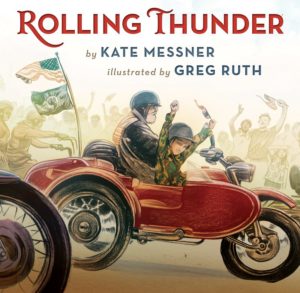
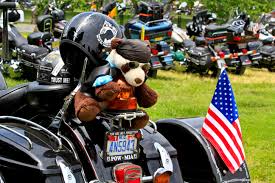
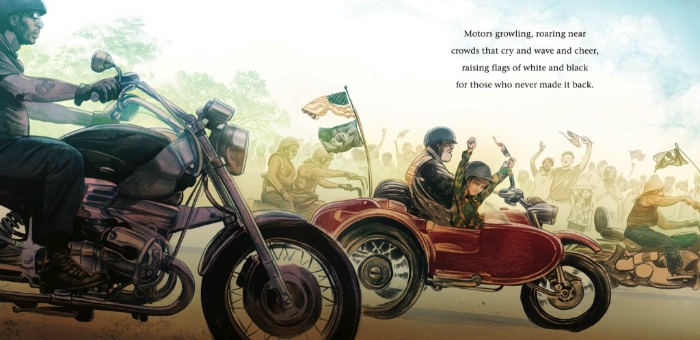
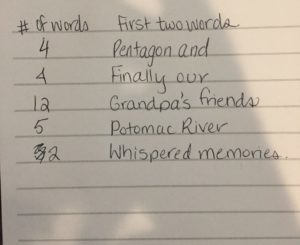





Leave a Reply